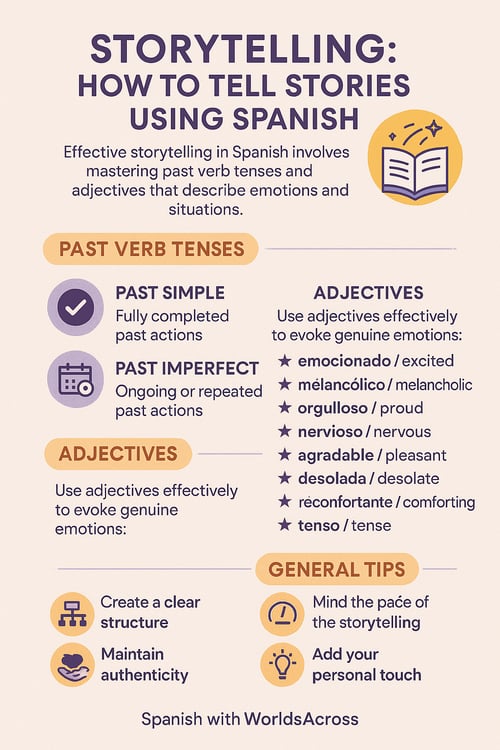Storytelling: How To Tell Stories Using Spanish

The best stories aren't just a series of events; they're the ones that evoke genuine emotions in their listeners and transport them to another world. If you want to master the art of storytelling in Spanish, this article is for you! In the following lines, we'll explore the importance of past tenses and adjectives for describing emotions and situations—key elements for any good storyteller in Spanish. Let’s get started!

Past Verb Tenses
First and foremost, to tell stories effectively, it's crucial to master the verb tenses that allow us to recreate situations and relive past emotions. In Spanish, both The past perfect simple and Past Imperfect are ideal for this purpose.
Past Perfect Simple
The past perfect simple is used to express specific past actions that were fully completed. For example:
“Al ver la tormenta que se avecinaba, Ismael corrió tan rápido como pudo y cerró todas las ventanas de la casa.”
Thanks to the use of The past perfect simple in ran and closed, we understand that these actions took place at a specific moment in the past and were fully completed.
Past Imperfect
Another verb tense we need to use to tell stories in Spanish appropriately is the Past Imperfect. This tense describes actions that were ongoing or repeated in the past without defining their start and end. For example:
“A medida que la noche llegaba, yo caminaba descalzo por el camino de tierra y recordaba las palabras de aquella dulce señorita.”
In this case, the Past Imperfect indicates that walking and remembering were continuous actions as night was falling.
Adjectives to Describe Emotions and Situations
To capture attention when telling stories in Spanish, it’s important to use adjectives that not only describe but also allow listeners to emotionally connect with the characters and properly imagine the atmosphere. Here are some examples:
Adjectives for Emotions
- Excited: Describes a strong feeling of joy or enthusiasm.
Example: Estaba tan emocionado por mi viaje que no pude dormir en toda la noche. - Melancholic: Reflects a soft sadness, often associated with the past.
Example: No pudo evitar sentirse melancólico al leer las cartas que le escribió su padre. - Proud: Indicates personal satisfaction or pride in others.
Example: Estaba orgullosa de ver a sus hijos cumpliendo sus sueños. - Nervous: Describes a feeling of unease.
Example: Estaba tan nerviosa que me sudaban las manos.
Adjectives for Situations
- Pleasant: Creates a sense of pleasure or comfort.
Example: El reencuentro fue muy agradable; disfrutamos cada minuto que pasamos juntos. - Desolate: Reflects a sense of emptiness and abandonment.
Example: Luego de su partida, la casa se sentía desolada. - Comforting: Provides relief or consolation.
Example: Conversar con mi madre después de ese largo día fue verdaderamente reconfortante. - Tense: Describes a state of discomfort and stress.
Example: Tras esa discusión, el ambiente se tornó realmente tenso.
General Tips
Congratulations! Now you know how to tell stories in Spanish using the correct verb tenses and appropriate adjectives. However, there are still more aspects to consider to perfect your storytelling skills in Spanish. Here are some additional tips:
-
Create a Clear Structure
Every good story needs a clear and organized structure to narrate the events effectively and maintain the listeners’ attention. Make sure to have an introduction that sets the context and characters, a development that narrates the events chronologically, a climax that highlights key moments, and a good ending to wrap up the story.
-
Maintain Authenticity
Avoid exaggerating the facts to make the story more appealing, as this may cause listeners to lose credibility and emotional connection. Respect the reality of the story to maintain authenticity.
-
Mind the Pace of the Storytelling
If a story starts out interesting but loses attention, it might be due to a monotonous pace. Alternate the speeds when telling stories to keep listeners engaged, even with simple stories.

-
Include Temporal Connectors
Integrate temporal connectors like “luego”, “mientras tanto”, “a medida que”, “a continuación”, “antes de” and “finalmente”. Besides maintaining a logical sequence, these connectors serve as guides for listeners and allow for smooth and natural transitions between events.
-
Add Your Personal Touch
Let your imagination run wild! Even when telling real stories, allow your creativity to shine. Play with words and body language. Don’t try to imitate others’ storytelling style; your personal touch is what turns an ordinary story into something truly special.
At the end of the day, the best stories create a genuine connection between the storyteller and their audience. Apply the shared tips, use verb tenses correctly, include appropriate adjectives, and add your personal touch. This way, your stories will stay in the minds of those who hear them.
See you next time!



